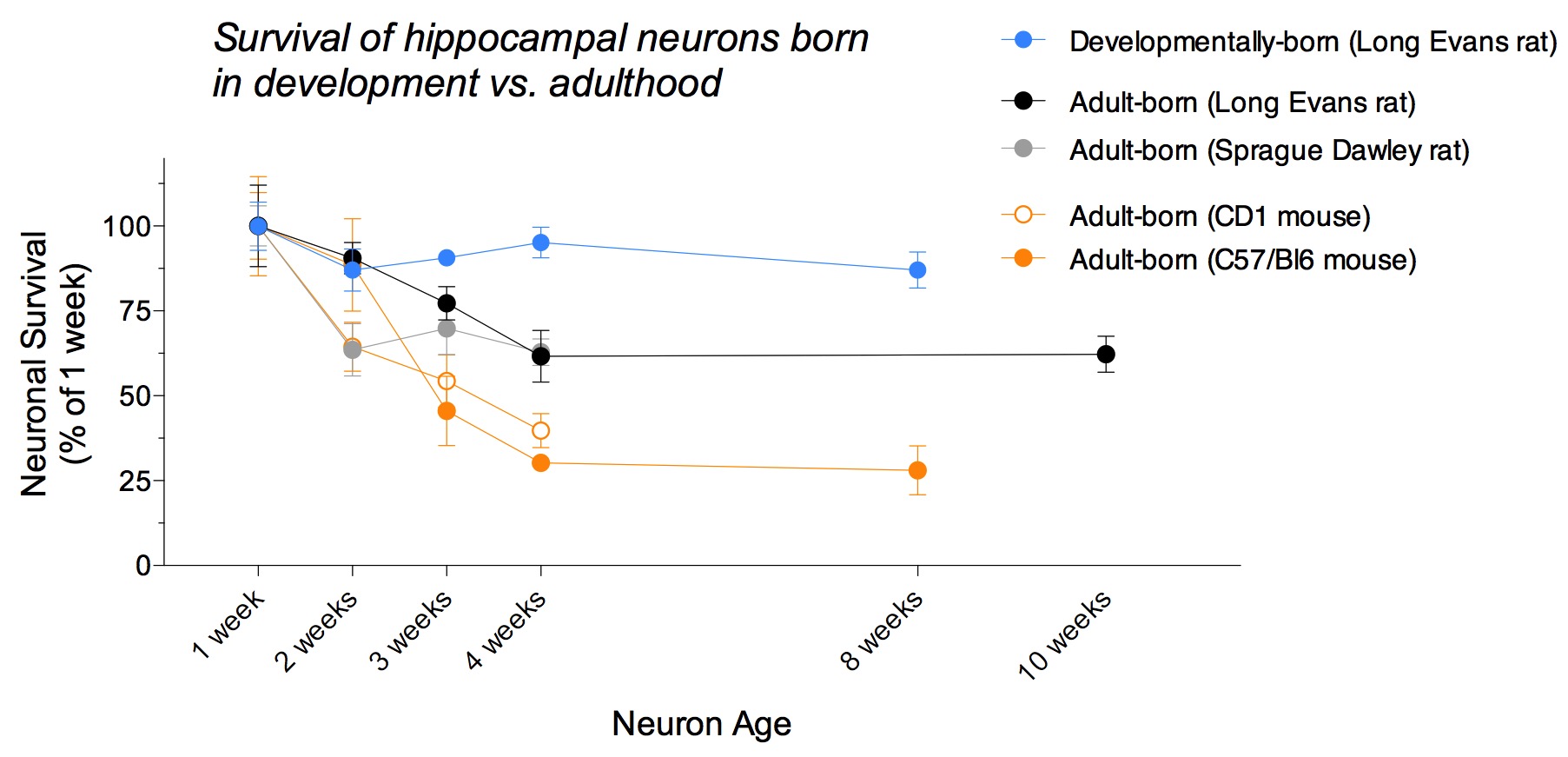Those who know me know that I love timecourses. Everything changes over time and by characterizing these changes we can understand a phenomenon in its entirety, hopefully. We certainly can’t understand it if we don’t know how it changes over time! Despite all of the neurogenesis timecourse data I’ve summarized previously, there are still some gaps. For example, we still don’t know that much about how neurons born in infancy compare to neurons born in adulthood, and whether they go through the same growth processes. This was one of the questions I proposed to NSERC 3.5 years ago, which was funded, and is finally beginning to see the light of day. Much of this work is still in progress since, well, timecourses take time! Our model, the rat, lives for 2 years and so studying developmentally-born neurons means labelling those cells in infancy and then letting the rat grow up, letting those neurons do their thing, for 2 full years. It’s completely understandable that people get frustrated when scientists cannot find cures for diseases fast enough. It’s frustrating for the scientists too! But there’s no easy way around it – research takes time.
One of the aspects of research that excites me the most is the way we do science. Traditionally, in a study where just one of the experiments take over 2 years, it could take 3 years or more to complete the experiments and another year to go through the publication process. Some of the data may have been produced by year 1 but no one can read about it for another 3 years! What is more soul-killing than having a discovery to share with the world and not sharing it? Or not sharing it for 3 more years*? Is a discovery a discovery if no one ever shares it? If a tree falls on a discovery in the woods and a squirrel hears it but then gets run over by a truck before…Well, I think you know what I am trying to say here.
It is well established that neurons born in the dentate gyrus of the adult hippocampus die off over the course of 4 weeks, and then remain stable for many months or even years. This has been demonstrated in mice and rats. We don’t really know why these new neurons die during their first 4 weeks of life. Possibly it is part of a competitive process whereby extra neurons are produced and the ones that store the relevant information are retained and “irrelevant” neurons are culled. We believe that the immature neurons may alter behavior depending on the experiences that an individual encounters, whether good or bad. They’re plastic / sensitive / moldable during this immature stage where neurons either die or survive. But what about the dentate gyrus neurons born in development – do they die off during their immature stages? Surprisingly, we don’t know. And yet early life events can play a big role in shaping how we behave as adults, and also the disorders we may acquire. So we decided to characterize how neurons born in infancy, in the rat, survive during their first few weeks of life. We also compared them to neurons born in adulthood in mice and rats**:

These data are new and may undergo some minor changes as we continue to analyze, but basically they’re complete. Six day old rats were injected with the mitotic marker BrdU to label neurons born on that day in infancy. We then counted how many of those neurons were present 1,2,3,4,8 weeks later. We made the 1 week values 100% and then expressed the later timepoints as the fraction that survived. Our new data is the blue curve: developmentally-born neurons in the Long Evans rat. You can see that there is no change over time! This is very different from what you in the adult rat, where 40% of adult-born neurons die during by 4 weeks. In adult mice the process is similar to rats except even more neurons die. So, something fundamentally different is happening in infancy. It seems that the developing dentate gyrus needs to keep all of the 1 week-old neurons, perhaps because the demands are different (brain needs to remember everything?), or maybe the function of the neurons is different than in adulthood.
This work was done by PhD student Shaina Cahill and undergraduate assistants Dylan Green and Ru Qi Yu.
*by which point you may no longer even care about some discoveries and then don’t bother sharing them
**other mouse and rat data from Snyder et al. (2009) J Neurosci
These data are also available on Figshare:
Cahill, Shaina; Qi Yu, Ru; Green, Dylan; Snyder, Jason (2016): Survival of neurons born in the developing rat dentate gyrus. Figshare.
https://dx.doi.org/10.6084/m9.figshare.3172225.v1
Pingback: Everything you always wanted to know about neurogenesis timecourses (but were afraid to ask)